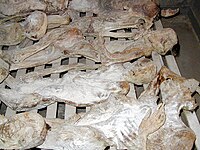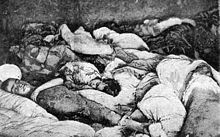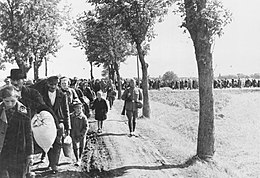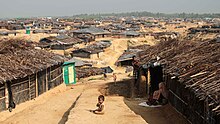Ethnic cleansing
| Part of a series on |
| Discrimination |
|---|
General forms
|
Specific forms |
Social
|
Manifestations
|
Policies
|
Countermeasures
|
Related topics
|
Ethnic cleansing is the systematic forced removal of ethnic or racial groups from a given territory by a more powerful ethnic group, often with the intent of making it ethnically homogeneous.[1][page needed] The forces applied may be various forms of forced migration (deportation, population transfer), intimidation, as well as genocide and genocidal rape.
Ethnic cleansing is usually accompanied with efforts to remove physical and cultural evidence of the targeted group in the territory through the destruction of homes, social centers, farms, and infrastructure, and by the desecration of monuments, cemeteries, and places of worship.
Initially used by the perpetrators during the Yugoslav Wars and cited in this context as a euphemism akin to that of Nazi Germany's "Final Solution", by the 1990s, the term gained widespread acceptance due to journalism and the media's heightened use of the term in its generic meaning.[2]
Contents
1 Etymology
2 Definitions
3 As a crime under international law
4 Genocide
5 As a military, political and economic tactic
6 Silent ethnic cleansing
7 Instances
8 Criticism of the term
9 See also
10 Notes
11 References
12 Further reading
13 External links
Etymology
An antecedent to the term is the Greek word andrapodismos (Greek: ανδραποδισμός; lit. "enslavement"), which was used in ancient texts to describe atrocities that accompanied Alexander the Great's conquest of Thebes in 335 BC.[3] In the early 1900s, regional variants of the term could be found among the Czechs (očista), the Poles (oczyszczanie), the French (épuration) and the Germans (Säuberung).[4][page needed] A 1913 Carnegie Endowment report condemning the actions of all participants in the Balkan Wars contained various new terms to describe brutalities committed toward ethnic groups.[5]

Massacres of Poles in Volhynia in 1943. Most Poles of Volhynia (now in Ukraine) had either been murdered or had fled the area.
During World War II, the euphemism čišćenje terena ("cleansing the terrain") was used by the Croatian Ustaše to describe military actions in which non-Croats were purposely killed or otherwise uprooted from their homes.[6]Viktor Gutić, a senior Ustaše leader, was one of the first Croatian nationalists on record to use the term as a euphemism for committing atrocities against Serbs.[7] The term was later used in the internal memorandums of Serbian Chetniks in reference to a number of retaliatory massacres they committed against Bosniaks and Croats between 1941 and 1945.[8] The Russian phrase очистка границ (ochistka granits; lit. "cleansing of borders") was used in Soviet documents of the early 1930s to refer to the forced resettlement of Polish people from the 22-kilometre (14 mi) border zone in the Byelorussian and Ukrainian SSRs. This process was repeated on an even larger scale in 1939–41, involving many other groups suspected of disloyalty towards the Soviet Union.[9] During The Holocaust, Nazi Germany pursued a policy of ensuring that Europe was "cleansed of Jews" (Judenrein).[10]
In its complete form, the term appeared for the first time in the Romanian language (purificare etnică) in an address by Vice Prime Minister Mihai Antonescu to cabinet members in July 1941. After the beginning of the invasion of the USSR,[clarification needed] he concluded: “I do not know when the Romanians will have such chance for ethnic cleansing."[11] In the 1980s, the Soviets used the term "ethnic cleansing" to describe the inter-ethnic violence in Nagorno-Karabakh.[3] At around the same time, the Yugoslav media used it to describe what they alleged was an Albanian nationalist plot to force all Serbs to leave Kosovo. It was widely popularized by the Western media during the Bosnian War (1992–95). The first recorded mention of its use in the Western media can be traced back to an article in The New York Times dated 15 April 1992, in a quote by an anonymous Western diplomat.[6]
Synonyms include ethnic purification.[12]
Definitions

Rwandan Genocide Murambi bodies
The Final Report of the Commission of Experts established pursuant to Security Council Resolution 780 defined ethnic cleansing as "a purposeful policy designed by one ethnic or religious group to remove by violent and terror-inspiring means the civilian population of another ethnic or religious group from certain geographic areas".[13] In its previous, first interim report it noted, "[b]ased on the many reports describing the policy and practices conducted in the former Yugoslavia, [that] 'ethnic cleansing' has been carried out by means of murder, torture, arbitrary arrest and detention, extra-judicial executions, rape and sexual assaults, confinement of civilian population in ghetto areas, forcible removal, displacement and deportation of civilian population, deliberate military attacks or threats of attacks on civilians and civilian areas, and wanton destruction of property. Those practices constitute crimes against humanity and can be assimilated to specific war crimes. Furthermore, such acts could also fall within the meaning of the Genocide Convention."[14]
The official United Nations definition of ethnic cleansing is "rendering an area ethnically homogeneous by using force or intimidation to remove from a given area persons of another ethnic or religious group".[15]
As a category, ethnic cleansing encompasses a continuum or spectrum of policies. In the words of Andrew Bell-Fialkoff:
[E]thnic cleansing [...] defies easy definition. At one end it is virtually indistinguishable from forced emigration and population exchange while at the other it merges with deportation and genocide. At the most general level, however, ethnic cleansing can be understood as the expulsion of a population from a given territory.[16]
Terry Martin has defined ethnic cleansing as "the forcible removal of an ethnically defined population from a given territory" and as "occupying the central part of a continuum between genocide on one end and nonviolent pressured ethnic emigration on the other end".[9]
In reviewing the International Court of Justice (ICJ) Bosnian Genocide Case in the judgement of Jorgic v. Germany on July 12, 2007 the European Court of Human Rights quoted from the ICJ ruling on the Bosnian Genocide Case to draw a distinction between ethnic cleansing and genocide:
.mw-parser-output .templatequote{overflow:hidden;margin:1em 0;padding:0 40px}.mw-parser-output .templatequote .templatequotecite{line-height:1.5em;text-align:left;padding-left:1.6em;margin-top:0}
The term 'ethnic cleansing' has frequently been employed to refer to the events in Bosnia and Herzegovina which are the subject of this case ... [UN] General Assembly resolution 47/121 referred in its Preamble to 'the abhorrent policy of "ethnic cleansing", which is a form of genocide', as being carried on in Bosnia and Herzegovina. ... It [i.e., ethnic cleansing] can only be a form of genocide within the meaning of the [Genocide] Convention, if it corresponds to or falls within one of the categories of acts prohibited by Article II of the Convention. Neither the intent, as a matter of policy, to render an area "ethnically homogeneous", nor the operations that may be carried out to implement such policy, can as such be designated as genocide: the intent that characterizes genocide is "to destroy, in whole or in part" a particular group, and deportation or displacement of the members of a group, even if effected by force, is not necessarily equivalent to destruction of that group, nor is such destruction an automatic consequence of the displacement. This is not to say that acts described as 'ethnic cleansing' may never constitute genocide, if they are such as to be characterized as, for example, 'deliberately inflicting on the group conditions of life calculated to bring about its physical destruction in whole or in part', contrary to Article II, paragraph (c), of the Convention, provided such action is carried out with the necessary specific intent (dolus specialis), that is to say with a view to the destruction of the group, as distinct from its removal from the region. As the ICTY has observed, while 'there are obvious similarities between a genocidal policy and the policy commonly known as 'ethnic cleansing' (Krstić, IT-98-33-T, Trial Chamber Judgment, 2 August 2001, para. 562), yet '[a] clear distinction must be drawn between physical destruction and mere dissolution of a group. The expulsion of a group or part of a group does not in itself suffice for genocide.'
— ECHR quoting the ICJ.[17]
As a crime under international law
There is no international treaty that specifies a specific crime of ethnic cleansing.[18] However, ethnic cleansing in the broad sense—the forcible deportation of a population—is defined as a crime against humanity under the statutes of both International Criminal Court (ICC) and the International Criminal Tribunal for the Former Yugoslavia (ICTY).[19] The gross human-rights violations integral to stricter definitions of ethnic cleansing are treated as separate crimes falling under public international law of crimes against humanity and in certain circumstances genocide.[20]
There are however situations, such as the expulsion of Germans after World War II, where ethnic cleansing has taken place without legal redress (see Preussische Treuhand v. Poland). Timothy V. Waters argues therefore that similar ethnic cleansing could go unpunished in the future.[21]
Genocide

Armenian Genocide victims
Academic discourse considers both genocide and ethnic cleansing to exist in a spectrum of assaults on nations or religio-ethnic groups. Ethnic cleansing is similar to forced deportation or population transfer whereas genocide is the intentional murder of part or all of a particular ethnic, racial, religious, or national group. While ethnic cleansing and genocide may share the same goal and the acts used to perpetrate both crimes may often resemble each other, ethnic cleansing is intended to displace a persecuted population from a given territory, while genocide is intended to destroy a population.[22]
Some academics consider genocide as a subset of "murderous ethnic cleansing".[23] Thus, these concepts are different, but related, as Norman Naimark writes: "literally and figuratively, ethnic cleansing bleeds into genocide, as mass murder is committed in order to rid the land of a people".[24] William Schabas adds, "Ethnic cleansing is also a warning sign of genocide to come. Genocide is the last resort of the frustrated ethnic cleanser."[22]
As a military, political and economic tactic

The 12th anniversary exhibition of ethnic cleansing in Abkhazia, which was held in Tbilisi in 2005.
In 1946 Königsberg was renamed Kaliningrad. The survivors of the German population were forcibly expelled and the city was repopulated with Soviet citizens.
In the 1990s Bosnian war, ethnic cleansing was a common phenomenon. It typically entailed intimidation, forced expulsion and/or killing of the undesired ethnic group, as well as the destruction or removal of key physical and cultural elements. These included places of worship, cemeteries, works of art and historic buildings. According to numerous ICTY verdicts, both Serb[25] and Croat[26] forces performed ethnic cleansing of their intended territories in order to create ethnically pure states (Republika Srpska and Herzeg-Bosnia). Serb forces were also judged to have committed genocide in Srebrenica and Zepa at the end of the war.[27]

Mass expulsion of Poles in 1939 as part of the German ethnic cleansing of western Poland annexed to the Reich.
Based on the evidence of numerous attacks by Croat forces against Bosnian Muslims (Bosniaks), the ICTY Trial Chamber concluded in the Kordić and Čerkez case that by April 1993, the Croat leadership from Bosnia and Herzegovina had a designated plan to ethnically cleanse Bosniaks from the Lašva Valley in Central Bosnia. Dario Kordić, the local political leader, was found to be the instigator of this plan.[28]
In the same year (1993), ethnic cleansing was also occurring in another country. During the Georgian-Abkhaz conflict, the armed Abkhaz separatist insurgency implemented a campaign of ethnic cleansing against the large population of ethnic Georgians.[citation needed] This was actually a case of trying to drive out a majority, rather than a minority, since Georgians were the single largest ethnic group in pre-war Abkhazia, with a 45.7% plurality as of 1989.[29] As a result of this deliberate campaign by the Abkhaz separatists, more than 250,000 ethnic Georgians were forced to flee, and approximately 30,000 people were killed during separate incidents involving massacres and expulsions (see Ethnic cleansing of Georgians in Abkhazia).[30][page needed][31][page needed] This was recognized as ethnic cleansing by Organization for Security and Co-operation in Europe conventions, and was also mentioned in UN General Assembly Resolution GA/10708.[32]
As a tactic, ethnic cleansing has a number of systemic impacts. It enables a force to eliminate civilian support for resistance by eliminating the civilians—recognizing Mao Zedong's dictum that guerrillas among a civilian population are fish in water, it removes the fish by draining the water[citation needed]. When enforced as part of a political settlement, as happened with the forced resettlement of ethnic Germans to the new Germany after 1945, it can contribute to long-term stability.[33][page needed] Some individuals of the large German population in Czechoslovakia and prewar Poland had encouraged Nazi jingoism before the Second World War, but this was forcibly resolved.[34][page needed] It thus establishes "facts on the ground"—radical demographic changes which can be very hard to reverse.
Silent ethnic cleansing

A ceremony marking the 16th anniversary of Operation Storm, which resulted in the expulsion of more than 200,000 ethnic Serbs from Croatia.[35]
Silent ethnic cleansing is a term coined in the mid-1990s by some observers of the Yugoslav Wars. Apparently concerned with Western media representations of atrocities committed in the conflict—which generally focused on those perpetrated by the Serbs—atrocities committed against Serbs were dubbed "silent" on the grounds that they did not receive adequate coverage.[36]
Some incidents in Northern Ireland and during the Troubles between Protestants and Catholics were considered to be "ethnic cleansing".[37][38] This included events after the Holy Cross dispute in 2001 when Protestant paramilitaries were accused of carrying out ethnic cleansing of Catholics in north Belfast.[39][40]
Instances

Rohingya refugees from Myanmar, March 2017
In many cases where accusations of ethnic cleansing have circulated, partisans have fiercely disputed such an interpretation and the details of the events which have been described as ethnic cleansing by academic or legal experts. This often leads to the promotion of vastly different versions of the event in question.
Criticism of the term
Gregory Stanton, the founder of Genocide Watch, has criticised the rise of the term and its use for events that he feels should be called "genocide": as "ethnic cleansing" has no legal definition, its media use can detract attention from events that should be prosecuted as genocide.[41][42] Because of widespread acceptance after media influence, it has become a term used legally, but carries no legal repercussions as there is no legal definition.
In 1992, the German equivalent of ethnic cleansing" (German: Ethnische Säuberung) was named German Un-Word of the Year by the Gesellschaft für deutsche Sprache due to its euphemistic, inappropriate nature.[43]
See also
- Communal violence
- Crimes against humanity
Ethnic Cleansing, a computer game- Ethnocide
- Eugenics
- Genocidal massacre
- Identity cleansing
- Indian Removal Act
- Missouri Executive Order 44
- Monoethnicity
- Population transfer
- Religious cleansing
- Rule of Law in Armed Conflicts Project (RULAC)
- Social cleansing
- State collapse
- Transmigration program
Notes
^ Rubenstein, James M. (2008). The Cultural Landscape: An Introduction to Human Geography. Pearson,. ISBN 9780131346819..mw-parser-output cite.citation{font-style:inherit}.mw-parser-output q{quotes:"""""""'""'"}.mw-parser-output code.cs1-code{color:inherit;background:inherit;border:inherit;padding:inherit}.mw-parser-output .cs1-lock-free a{background:url("//upload.wikimedia.org/wikipedia/commons/thumb/6/65/Lock-green.svg/9px-Lock-green.svg.png")no-repeat;background-position:right .1em center}.mw-parser-output .cs1-lock-limited a,.mw-parser-output .cs1-lock-registration a{background:url("//upload.wikimedia.org/wikipedia/commons/thumb/d/d6/Lock-gray-alt-2.svg/9px-Lock-gray-alt-2.svg.png")no-repeat;background-position:right .1em center}.mw-parser-output .cs1-lock-subscription a{background:url("//upload.wikimedia.org/wikipedia/commons/thumb/a/aa/Lock-red-alt-2.svg/9px-Lock-red-alt-2.svg.png")no-repeat;background-position:right .1em center}.mw-parser-output .cs1-subscription,.mw-parser-output .cs1-registration{color:#555}.mw-parser-output .cs1-subscription span,.mw-parser-output .cs1-registration span{border-bottom:1px dotted;cursor:help}.mw-parser-output .cs1-hidden-error{display:none;font-size:100%}.mw-parser-output .cs1-visible-error{font-size:100%}.mw-parser-output .cs1-subscription,.mw-parser-output .cs1-registration,.mw-parser-output .cs1-format{font-size:95%}.mw-parser-output .cs1-kern-left,.mw-parser-output .cs1-kern-wl-left{padding-left:0.2em}.mw-parser-output .cs1-kern-right,.mw-parser-output .cs1-kern-wl-right{padding-right:0.2em}
^ Thum, Gregor (2006–2007). "Ethnic Cleansing in Eastern Europe after 1945". Contemporary European History. 19 (1): 75–81. doi:10.1017/S0960777309990257.
^ ab Booth, Ken (2012). The Kosovo Tragedy: The Human Rights Dimensions. London: Routledge. p. 48. ISBN 978-1-13633-476-4.
^ Ther, Philip (2004). "The Spell of the Homogeneous Nation State: Structural Factors and Agents of Ethnic Cleansing". In Rainer Munz; Rainer Ohliger. Diasporas and Ethnic Migrants: Germany, Israel and Russia in Comparative Perspective. London: Routledge. ISBN 978-1-13575-938-4.
^ Akhund, Nadine (December 31, 2012). "The Two Carnegie Reports: From the Balkan Expedition of 1913 to the Albanian Trip of 1921". Balkanologie. Revue d'études pluridisciplinaires (Vol. XIV, n° 1-2) – via balkanologie.revues.org.
^ ab Toal, Gerard; Dahlman, Carl T. (2011). Bosnia Remade: Ethnic Cleansing and Its Reversal. New York: Oxford University Press. p. 3. ISBN 978-0-19-973036-0.
^ West, Richard (1994). Tito and the Rise and Fall of Yugoslavia. New York: Carroll & Graf. p. 93. ISBN 978-0-7867-0332-6.
^ Becirevic, Edina (2014). Genocide on the River Drina. New Haven, Connecticut: Yale University Press. pp. 22–23. ISBN 978-0-3001-9258-2.
^ ab Martin, Terry (1998). "The Origins of Soviet Ethnic Cleansing". The Journal of Modern History 70 (4), 813–861. pg. 822
^ Fulbrooke, Mary (2004). A Concise History of Germany. Cambridge: Cambridge University Press. p. 197. ISBN 978-0-52154-071-1.
^ Petrovic, Vladimir (2017). Ethnopolitical Temptations Reach Southeastern Europe: Wartime Policy Papers of Vasa Čubrilović and Sabin Manuilă. CEU Press.
^ Petrovic, Drazen (1994). "Ethnic Cleansing – An Attempt at Methodology" (PDF). European Journal of International Law. 5 (3): 343. Retrieved May 20, 2006.In English, reference is also made to 'ethnic purification'.
^ "Final Report of the Commission of Experts Established Pursuant to United Nations Security Council Resolution 780 (1992)" (PDF). United Nations Security Council. May 27, 1994. p. 33.Upon examination of reported information, specific studies and investigations, the Commission confirms its earlier view that 'ethnic cleansing' is a purposeful policy designed by one ethnic or religious group to remove by violent and terror-inspiring means the civilian population of another ethnic or religious group from certain geographic areas. To a large extent, it is carried out in the name of misguided nationalism, historic grievances and a powerful driving sense of revenge. This purpose appears to be the occupation of territory to the exclusion of the purged group or groups. This policy and the practices of warring factions are described separately in the following paragraphs.
Paragraph 130.
^ "Final Report of the Commission of Experts Established Pursuant to United Nations Security Council Resolution 780 (1992)" (PDF). United Nations Security Council. May 27, 1994. p. 33. Paragraph 129
^ Hayden, Robert M. (1996) "Schindler's Fate: Genocide, Ethnic Cleansing, and Population Transfers". Slavic Review 55 (4), 727-48.
^ Andrew Bell-Fialkoff, "A Brief History of Ethnic Cleansing" Archived February 3, 2004, at the Wayback Machine., Foreign Affairs 72 (3): 110, Summer 1993. Retrieved May 20, 2006.
^ ECHR Jorgic v. Germany §45 citing Bosnia and Herzegovina v. Serbia and Montenegro ("Case concerning application of the Convention on the Prevention and Punishment of the Crime of Genocide"), the International Court of Justice (ICJ) found under the heading of “intent and ‘ethnic cleansing’” (at § 190)
^ Ferdinandusse, Ward (2004). The Interaction of National and International Approaches in the Repression of International Crimes (PDF). The European Journal of International Law. 15. p. 1042, note 7. Archived from the original (PDF) on July 5, 2008.
^ "Rome Statute of the International Criminal Court" Archived January 13, 2008, at the Wayback Machine., Article 7; Updated Statute of the International Criminal Tribunal for the Former Yugoslavia, Article 5.
^ Shraga, Daphna; Zacklin, Ralph (2004). "The International Criminal Tribunal for the Former Yugoslavia". The European Journal of International Law. 15 (3). Archived from the original on September 27, 2007.
^ Timothy V. Waters, "On the Legal Construction of Ethnic Cleansing", Paper 951, 2006, University of Mississippi School of Law. Retrieved on 2006, 12–13
^ ab Schabas, William (2000). Genocide in International Law. Cambridge: Cambridge University Press. pp. 199–201. ISBN 9780521787901.
^ Mann, Michael (2005). The Dark Side of Democracy: Explaining Ethnic Cleansing. Cambridge: Cambridge University Press. p. 17. ISBN 9780521538541.
^ Naimark, Norman (4 November 2007). "Theoretical Paper: Ethnic Cleansing". Online Encyclopedia of Mass Violence. Archived from the original on 6 March 2016.
^ "ICTY: Radoslav Brđanin judgement". Archived from the original on April 14, 2009.
^ "ICTY: Kordić and Čerkez verdict". Archived from the original on June 27, 2009.
^ ICTY; "Address by ICTY President Theodor Meron, at Potočari Memorial Cemetery" The Hague, June 23, 2004 [1] Archived April 3, 2009, at the Wayback Machine.
^ "ICTY: Kordić and Čerkez verdict – IV. Attacks on towns and villages: killings – C. The April 1993 Conflagration in Vitez and the Lašva Valley – 3. The Attack on Ahmići (Paragraph 642)". Archived from the original on June 26, 2009.
^ US State Department, Country Reports on Human Rights Practices for 1993, Abkhazia case.
^ Chervonnaia, Svetlana Mikhailovna (1994). Conflict in the Caucasus: Georgia, Abkhazia, and the Russian Shadow. Gothic Image Publications. ASIN B0029XE6WO.
^ US State Department,Country Reports on Human Rights Practices for 1993, February 1994, Chapter 17.
^ ""General Assembly Adopts Resolution Recognizing Right Of Return By Refugees, Internally Displaced Persons To Abkhazia, Georgia"".
^ Judt, Tony. Postwar: A History of Europe Since 1945 Penguin Press, 2005
^ Tony Judt Postwar: A History of Europe Since 1945 Penguin Press, 2005.
^ "Evicted Serbs remember Storm ". BBC News. 5 August 2005.
^ Krauthammer, Charles: "When Serbs Are 'Cleansed,' Moralists Stay Silent", International Herald Tribune, August 12, 1995.
^ Chrisafis, Angelique (January 10, 2004). "Racist war of the loyalist street gangs". the Guardian.
^ "Unionists react angrily to IRA 'ethnic cleansing' border plan". The Irish News.
^ "Fresh trouble in Belfast". May 8, 2002 – via news.bbc.co.uk.
^ Cowan, Rosie (September 9, 2002). "'Ethnic cleansing' claim over Ulster attacks". the Guardian.
^ Blum, Rony; Stanton, Gregory H.; Sagi, Shira; Richter, Elihu D. (2007). "'Ethnic cleansing' bleaches the atrocities of genocide". European Journal of Public Health. 18 (2): 204–209. doi:10.1093/eurpub/ckm011. PMID 17513346.
^ See also "Ethnic Cleansing and Genocidal Intent: A Failure of Judicial Interpretation?", Genocide Studies and Prevention 5, 1 (April 2010), Douglas Singleterry
^ Gunkel, Christoph (October 31, 2010). "Ein Jahr, ein (Un-)Wort!" [One year, one (un)word!] (in German). Spiegel Online.
References
Bell-Fialkoff, Andrew (1993). "A Brief History of Ethnic Cleansing". Foreign Affairs. 72 (3): 110–121. doi:10.2307/20045626. JSTOR 20045626. Archived from the original on February 3, 2004.
Petrovic, Drazen (1998). "Ethnic Cleansing – An Attempt at Methodology" (PDF). European Journal of International Law. 5 (4): 817.
- Vladimir Petrović (2007), Etnicizacija čišćenja u reči i nedelu (Ethnicisation of Cleansing), Hereticus 1/2007, 11-36
Further reading
- Anderson, Gary Clayton. Ethnic Cleansing and the Indians: The Crime that Should Haunt America. Norman, Oklahoma: University of Oklahoma Press, 2014.
- de Zayas, Alfred M.: Nemesis at Potsdam, Routledge, London 1977.
- de Zayas, Alfred M.: A Terrible Revenge. Palgrave/Macmillan, New York, 1994.
ISBN 1-4039-7308-3. - de Zayas, Alfred M.: Die deutschen Vertriebenen. Leopold Stocker, Graz, 2006.
ISBN 3-902475-15-3. - de Zayas, Alfred M.: Heimatrecht ist Menschenrecht. Universitas, München 2001.
ISBN 3-8004-1416-3. - de Zayas, Alfred M.: "The Right to One's Homeland, Ethnic Cleansing and the International Criminal Tribunal for the Former Yugoslavia", Criminal Law Forum (2005)
- de Zayas, Alfred M.: "Forced Population Transfer" in Max Planck Encyclopedia of Public International Law, Oxford online 2010.
Carmichael, Cathie (2002). Ethnic cleansing in the Balkans: nationalism and the destruction of tradition (Illustrated ed.). Routledge. ISBN 0-415-27416-8.
ISBN 9780415274166.
- Douglas, R. M.: Orderly and Humane: The Expulsion of the Germans after the Second World War. Yale University Press, 2012
ISBN 978-0300166606. - Prauser, Steffen and Rees, Arfon: The Expulsion of the "German" Communities from Eastern Europe at the End of the Second Century. Florence, Italy, European University Institute, 2004.
Sundhaussen, Holm (2010). "Forced Ethnic Migration". European History Online.
Štrbac, Savo (2015). Gone with the Storm: A Chronicle of Ethnic Cleansing of Serbs from Croatia. Knin-Banja Luka-Beograd: Grafid, DIC Veritas.
External links
| Wikimedia Commons has media related to ethnic cleansing. |
| Look up ethnic cleansing in Wiktionary, the free dictionary. |
- Genocide of The Ethnic Germans in Yugoslavia 1944–1948
Photojournalist's Account – Images of ethnic cleansing in Sudan
Timothy V. Waters, On the Legal Construction of Ethnic Cleansing, Paper 951, 2006, University of Mississippi School of Law (PDF)
Dump the "ethnic cleansing" jargon, group implores May 31, 2007, World Science
Repa, Jan (March 29, 1999). "Ethnic cleansing: Revival of an old tradition". BBC News.